Dinger's Aviation Pages
NOTE THIS PAGE IS AN ARCHIVE - THE INFORMATION ON IT HAS NOT BEEN UPDATED SINCE 1995
SEPECAT JAGUAR
Back in 1995 I issued a DOS program on floppy disk called "RAF FASTJETS" which was written using IBM's "LINKWAY" product. All the information on this page is taken from that program, none of the data has been updated since 1995. The photos are from the collection of John Edwards.
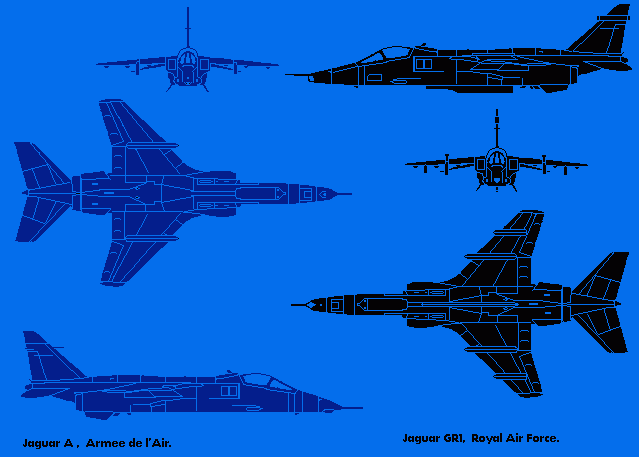
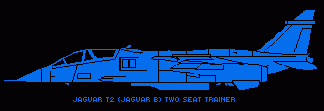
In the 1960s it was thought dedicated supersonic training aircraft would be needed to prepare pilots for the high-speed combat aircraft expected in the last quarter of the 20th Century. The cost of such a trainer was expected to be high, so in the spirit of the day, the British and French decided to combine efforts to produce one aircraft to meet the needs of both nations. At the same time replacements were needed for the Hunter fighter-bombers of the RAF and the F-100 Super Sabres of the French Air Force, and new carrier-borne strike aircraft were needed by the French Naval Air Arm. As the project progressed it was realised that the supersonic trainer was going to be too expensive to operate, but that a single-seat version of the aircraft would be ideal for the strike force of both countries.
The Jaguar marked a clear departure from the previous policy of using old fighters in the ground-attack role. The Jaguar was designed as a "bomb cart" able to haul a large load of bombs at a high subsonic speed at a low level and then make a supersonic escape after delivery.
The two-seater Jaguar design survived as a conversion trainer for the single-seat aircraft. Five versions emerged from the design phase...
JAGUAR A - French single-seat strike aircraft.
JAGUAR B - UK two-seat trainer.
JAGUAR E - French two-seat trainer.
JAGUAR M - French carrier-based single-seat strike aircraft.
JAGUAR S - UK single-seat strike aircraft.
The JAGUAR M project was cancelled and France ordered the Super Etendard instead.
Powered by two afterburning Adour turbofans developed by Rolls-Royce and Turbomeca, the Jaguar emerged as a high wing aircraft with a robust wide-set undercarriage which somehow manages to fold itself back into the slim fuselage. With numerous bulges, the Jaguar is not the prettiest of aircraft but it does have a sort of rugged charm. The two-seat version's front cockpit blends more with the lines of the nose and is better looking than the single-seat versions.

The RAF ended up with 202 Jags while the Armee de l'Air took delivery of 200. In RAF service, the Jaguar became the GR1A and was updated with more powerful engines, a laser marked-target seeker in a "chisel" nose and an inertial navigation system linked to a moving-map display. When first introduced the GR1A was the most advanced strike aircraft in service anywhere in the world. The inertial nav system, in particular, was a huge leap forward.
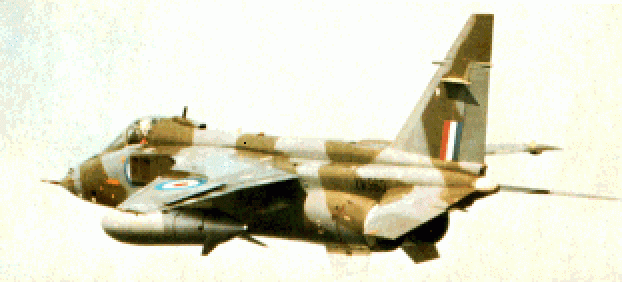
An early RAF Jaguar without chisel nose and radar warning aerial on the tail.
The French did not adopt the improved Adour engines, this proved a drawback since the French operated the Jaguar a lot in sub-Saharan Africa where the improved thrust would have helped performance in the "hot-and-high" conditions there. Many French Jaguars do have a laser range-finder in a small bulge under the nose, along with built-in photo-recce cameras (RAF Jaguars have cameras mounted in pods for fitting on the under-fuselage pylon). Some French Jaguar squadrons were earmarked for the tactical nuclear strike role with the AN52 nuclear weapon. The French Jaguars have also been equipped with the AS30L missile.
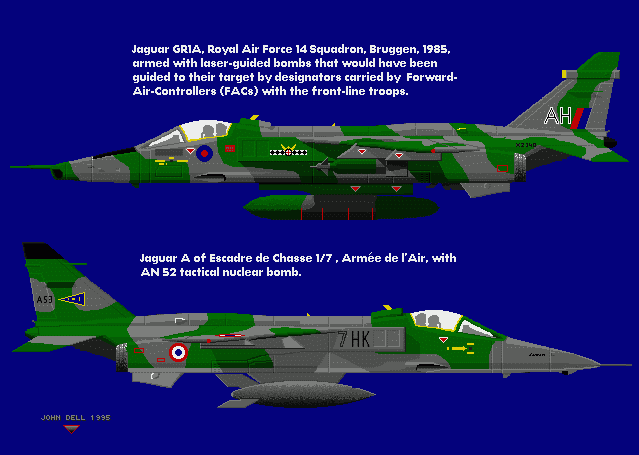
French Jaguars have seen action in Mauritania and Chad, but the biggest test for the Jag came in the war for Kuwait. Both British and French Jaguars operated in the Gulf. Before the air war began British commanders had decided not to use their Jaguars at low-level, but go for medium-level strikes with fighter and anti-radar missile support. This proved correct and British Jaguars had great success with bombs and rockets. The first French Jaguar mission of the war was flown at low level but 3 of the 12 aircraft were badly damaged by light flak and SAM7 hand-held missiles. After that, the French also flew at a higher level and started to use the AS30L to good effect.
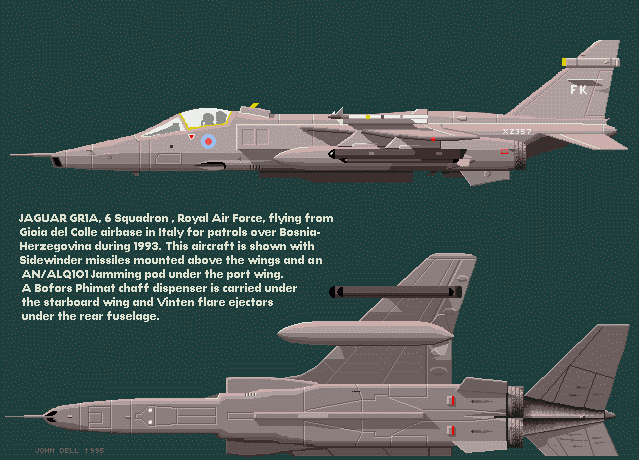
Since the Gulf War, the RAF has looked again at its Jaguar force and started a programme to update them to GR1B standard. This involves new electronic systems and the fitting of a TIALD pod (TV airborne laser designator). This will enable the use of laser guided bombs. The programme was rushed through to give NATO the means to hit pinpoint targets in the former Yugoslavia. Twelve aircraft were due to be modified under the initial contract.
The Sepecat company formed by Dassault-Breguet and British Aerospace to produce Jaguar has been successful in selling it to a number of nations. Most notable is India which has over 100 in its airforce, including a specialised maritime strike version. The export version is known as "Jaguar International" and most are built to the RAF standard (i.e. Jaguar S single-seat and Jaguar B two-seat).
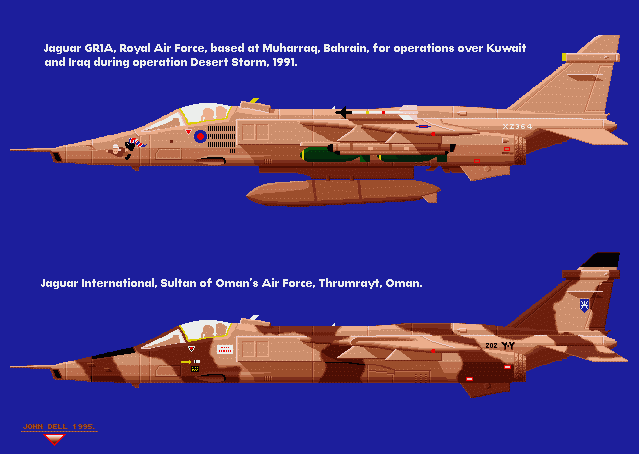
Jaguars are due for replacement by the Eurofighter in RAF service and by the Rafale in the Armee de l'Air.
One interesting point to note is that two other aircraft designed at the same time as the Jaguar ended up with the same two-engine high-wing layout and they can be very hard for even the best plane spotter to tell apart. The first look-alike is the Japanese Mitsubishi F-1 fighter which has the same Adour powerplant as the Jaguar. The second is the "Jurom" Orao, the product of Romanian and Yugoslavian co-operation, powered by two Rolls-Royce Viper 632 turbojets.
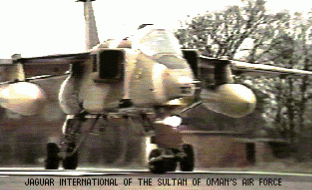

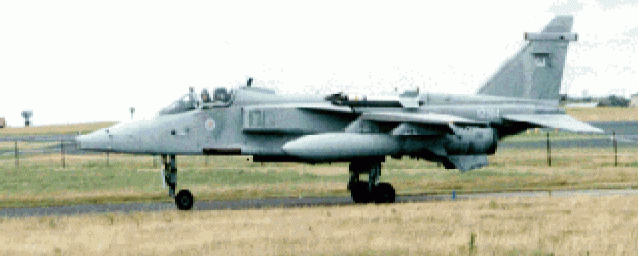
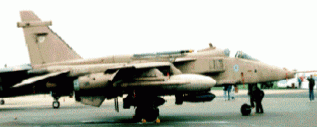
Gulf war Jaguar
POWER
Jaguar A and E:
French Jaguars are powered by two Mk102 versions of the Rolls-Royce/Turbomeca Adour turbofan which give 8040 lb (3647 kg) of thrust.
Jaguar GR1A, GR1B, TMk2:
Royal Air Force Jaguars are powered by more powerful Adour Mk 104s which give 8400 lb (3810 kg) of thrust.
Jaguar International:
Jaguar Internationals have been supplied with Adour Mk104 turbojets and also with the newer Mk811 version.
PERFORMANCE
Jaguar has a top speed of 1056 mph (1700 km/h) at high level and about 820 mph (1320 km/h) at low level. A combat radius of about 507 miles on internal fuel while carrying a small bombload can be extended by use of fuel tanks on the wing pylons and/or fuselage pylon. A ferry range of 2,614 miles (4210 km) has been demonstrated.
NOTE THIS PAGE IS AN ARCHIVE - THE INFORMATION ON IT HAS NOT BEEN UPDATED SINCE 1995
Updated info:
Both UK and French Jaguars operated over Bosnia.
The Jaguar was retired from French service in 2005.
The Jaguar left UK flying service in 2007, although some airframes were retained for ground handling training.
The Royal Air Force of Oman retired its Jaguars in 2014
As of 2025 Indian Air Force Jaguars continue in service They all received uprated Mk811 engines and have continued to be updated with advanced avionics and navigation equipment. They were used in the May 2025 clash with Pakistan, when they carried out stand-off attacks using Israeli produced Rampage missiles.
